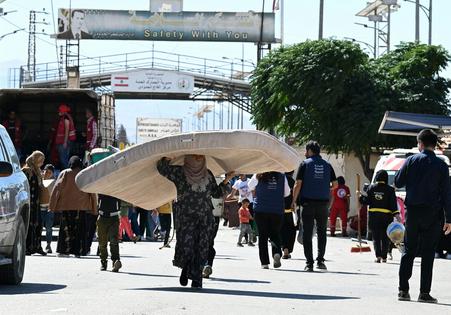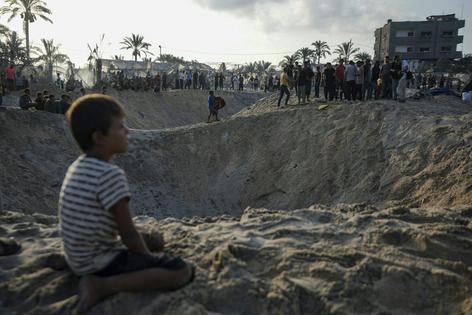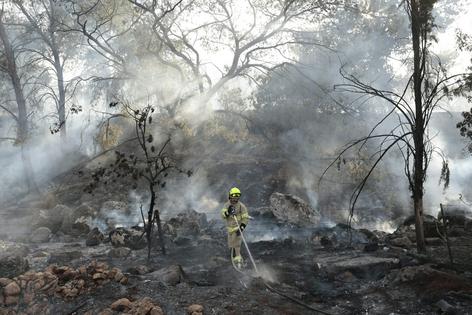A year of escalating conflict in the Middle East has ushered in a new era of regional displacement
Published in Political News
A year of conflict has ushered in a new era of mass displacement in the Middle East.
Since Hamas’ attack on Israel on Oct. 7, 2023, and the subsequent sustained Israeli bombardment of Gaza, Israel has expanded its operations on multiple fronts to include the West Bank, Yemen, Syria and Lebanon.
With fighting continuing unabated and the prospects for a direct confrontation between Iran and Israel rising, the region is now in a new period of internal and cross-border displacement that has already uprooted millions.
As scholars of migration, we fear that the results of such displacement will affect the region for years to come – and is likely to further hamper the ability of the region’s people to live safe and secure lives.
Israel’s ongoing attacks have forced nearly 2 million Palestinians to flee their homes in Gaza over the past year, amounting to 9 in 10 inhabitants of the densely populated strip.
What is unique about the scale of the displacement in Gaza is that nearly all internally displaced persons remain trapped, unable to leave the territory amid Israel’s ongoing border closure and bombardment.
This has intensified cascading humanitarian crises, including famine and the spread of disease, along with countless other hardships that make normal life nearly impossible.
For many Palestinians in Gaza, the yearlong bombardment has meant repeated displacement as Israeli attacks shift from area to area, amid shrinking humanitarian spaces.
And although there are complex historical and geopolitical reasons regarding the border closures, international law experts argue that Egypt and Israel have violated international refugee law by refusing to allow Palestinians in Gaza to cross the Rafah border to seek asylum.
The situation in Gaza is structurally different from previous displacement crises in the region – even in civil war-torn Syria, where cross-border aid operations have constantly been on the brink of collapse. That’s because Israel continues to limit and block aid into the territory, and humanitarian workers struggle to provide the bare minimum of food, shelter and medical care during bombing campaigns that have rarely stopped.
To make matters worse, the experience of the past year has shown that refugee camps, civilian apartment buildings, U.N. schools, and hospitals serving civilians and refugees are not safe spaces. Israel frequently justifies its attacks on such locations by saying they are used by Hamas or Hezbollah, despite formal U.N. disputes of many of these accusations. At least 220 U.N. workers have also been killed in these targeted Israeli attacks in the past year – more than any other crisis ever recorded.
This contributes to humanitarian workers struggling to access populations in need, especially displaced individuals. For its part, the United States continues to be the top donor to the the U.N. refugee agency (UNHCR) and the U.N. agency for Palestinian refugees (UNRWA), as well as the top supplier of weapons to Israel.
In Lebanon, massive displacement has also resulted from Israel’s developing war with Hezbollah.
Even before the September escalation of conflict across the Lebanon-Israel border, nearly 100,000 Lebanese had been displaced from their homes in the country’s south due to Israeli shelling. Meanwhile, approximately 63,000 Israelis were internally displaced from the country’s north due to Hezbollah’s rocket attacks.
But starting in late September 2024, Israeli strikes on Hezbollah and Palestinian targets in Beirut and across Lebanon killed hundreds of civilians and exponentially increased internal and cross-border displacement. More than 1 million Lebanese have now fled their homes in a matter of days amid Israel’s invasion and bombardment.
In addition, Syrian refugees and the large migrant worker population in Lebanon were also displaced, with many sleeping on the streets or in makeshift tents, unable to access buildings that were converted into shelters for Lebanese.
In a separate stark example of reverse migration, about 230,000 people – both Lebanese and Syrians – have fled across the border into Syria.
Bringing the recent regional conflicts full circle with post-2011 Arab uprising displacement and crisis, returning home is an unsafe option for many Syrians who still fear repression under the government of Syrian President Bashar al-Assad. Israel’s ongoing invasion of Lebanon is likely to only amplify these trends, as the country ordered numerous villages and towns in the country’s south – miles above the U.N.-recognized buffer zone – to evacuate.
Over several decades, the Middle East has experienced many large-scale, cross-border displacements for myriad reasons. The original forced displacement of Palestinians surrounding the creation of Israel in 1948 and subsequent conflicts created the world’s longest-standing refugee situation, with approximately 6 million Palestinians living across the Levant. The first Gulf War, sanctions against Iraq in the 1990s and the 2003 U.S. invasion of Iraq produced millions of refugees, with long-standing political repercussions for the region.
More recently, the 2011 Arab uprisings and the wars that followed in Syria, Yemen and Libya created millions of refugees, as well as internally displaced peoples, with nearly 6 million Syrians still living in Turkey, Lebanon and Jordan and another 6 million displaced inside Syria. Because Syrians have largely not returned home, international organizations have become a semipermanent safety net to provide basic services to refugees and host communities.
New layers of displacement in Lebanon – nationals, refugees and migrant workers – as well as cross-border movement into Syria will put further strain on the underfunded system of humanitarian assistance.
Further, the current Israel-Hezbollah war in Lebanon is not the first time conflict between the state and its neighbor to the north has preceded large-scale displacement. In an attempt to eliminate the Palestinian Liberation Organization, Israel invaded Lebanon in 1978 and again in 1982. Israel’s 1982 invasion led to the Sabra and Shatila massacres of between 1,500-3000 Palestinian civilians – carried out by Israel’s Lebanese Christian allies – showing that military operations that do not distinguish between militants and civilians can lead to devastating impacts for displaced populations.
Between 600,000 and 900,000 Lebanese fled abroad during the entire course of the country’s civil war from 1975 to 1990.
Two decades later, Israel again invaded Lebanon in 2006 in an attempt to stamp out Hezbollah, leading approximately 900,000 Lebanese to flee the south – both internally and across the border into Syria.
While the speed and volume of Lebanese displacement in 2006 was unprecedented at the time, the number of people forced to flee in late September and early October 2024 has quickly surpassed that record.
So, the region is well versed with the consequences of mass displacement. But what is clear a year into the current conflict is that the Middle East is now in a new era of displacement – in terms of scale and kind.
And the number of families’ lives disrupted by this new era of displacement looks set only to increase. Tensions in the region have escalated further with fresh missile attacks against Israel from Iran and threats of retaliation by Israel.
The experience of decades of conflict in the region is that civilians are most likely to bear the brunt of fighting – whether through forced displacement, an inability to access food or medical care, or death.
Only by way of a cessation of current hostilities and a lasting cease-fire across the region can the conditions be set for at-risk populations to begin to return and rebuild. This is particularly true for those displaced in Gaza who have been repeatedly forced from their homes, but have no borders over which they can cross to safety, and for whom a political solution remains elusive.
This article is republished from The Conversation, a nonprofit, independent news organization bringing you facts and trustworthy analysis to help you make sense of our complex world. It was written by: Nicholas R. Micinski, University of Maine and Kelsey Norman, Rice University
Read more:
Israeli actions have the cover of ‘moral hazard’ − a touch of ambiguity might give US pressure greater weight
A year after Hamas attack, more continuity than change for the Palestinians and Israel
Iran’s strike on Israel was retaliatory – but it was also about saving face and restoring deterrence
The authors do not work for, consult, own shares in or receive funding from any company or organization that would benefit from this article, and have disclosed no relevant affiliations beyond their academic appointment.


































































Comments